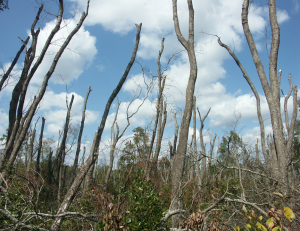
In this phylogenetic tree, Species A is more closely related to Species B than it is to Species C. Species I is more genetically distinct than Species F. Image by Tylototriton, courtesy of Wikimedia Commons.
Conservation goals range anywhere from aesthetics to survival. Among the most important of those is ensuring that an ecosystem is resilient to disturbances and provides as many different functions as possible. According to an assessment by a USDA Forest Service cooperating researcher, those qualities can be quantified using two metrics: rarity and evolutionary distinctiveness.
Rarity is a measure of how frequently a species occurs. Is the species found in one valley or across an entire continent? In what types of habitats is it found? How many individuals of that species can be found on a specific plot of land?.
Evolutionary distinctiveness is a measure of how closely related a species is to its relatives and ancestors. On a family tree, species which split most recently from their common ancestor are related more closely with one another. These species are likely to possess similar traits and thus function similarly within an ecosystem.
However, those species which diverged longer ago are less related to others on their family tree and are more evolutionarily distinct. They might have traits that others do not, and therefore play a unique role within the ecosystem. This makes them, too, a priority for conservation.
In his recent study, NC State University research associate professor and USDA Forest Service collaborator Kevin Potter assesses the rarity and evolutionary distinctiveness of tree species throughout the U.S. using data collected from about 130,000 Forest Inventory and Analysis plots.
The results were published in Biological Conservation. He identifies “hotspots” and “coldspots” where there are especially high or low concentrations of rare or evolutionarily distinctive tree species. According to him, paying attention to these species and locations is one way to get “more conservation bang for your buck.”
This study builds upon Potter’s previous work in the field of evolutionary biology, helping managers and scientists protect forests from threats like climate change and invasive species.
In this new work, he asks if tree rarity and evolutionary distinctiveness are higher or lower within the nation’s designated protected areas than outside of them. In other words, are we doing a good job of protecting our forests’ genetic resources?
Examples of highly rare and evolutionarily distinct trees include the sequoia, the Florida yew, and the Florida torreya. Additionally, hotspots of a combined rarity-evolutionary distinctiveness metric are located throughout the southern region and along the west coast.
Effective conservation is urgently needed in those areas because they are where, if lost, the biodiversity is more likely to be irreplaceable.
However, when it comes to rarity and evolutionary distinctiveness as separate metrics, the map changes. Hotspots of rarity are often coldspots of evolutionary distinctiveness. Therefore, managers should be aware of where they are situated within this regional variation.
The biggest unanswered question still remains—are we protecting those hotspots? Potter’s analysis reveals a number of interesting answers to that question.
For one, multiple-use protected areas—like national forests—are better at conserving evolutionary distinctiveness and the combined rarity-evolutionary distinctiveness metric than those that are restricted-use, like national parks and wildlife refuges.
Secondly, although protected areas tend to be better at conserving evolutionary distinctiveness, unprotected areas tend to be better at conserving rarity and the combined rarity-evolutionary distinctiveness metric. Exceptions to this trend include the protected areas in the southern region—there, evolutionary distinctiveness needs more attention.
Reviewing information about tree rarity and evolutionary distinctiveness will help managers maintain that biodiversity in their forests and strengthen their insurance policy against any disturbances that come along.
For more information, and a sound recording of Kevin Potter describing this research, see this blog posting from the U.S. Forest Service Southern Research Station.
July 19, 2018




